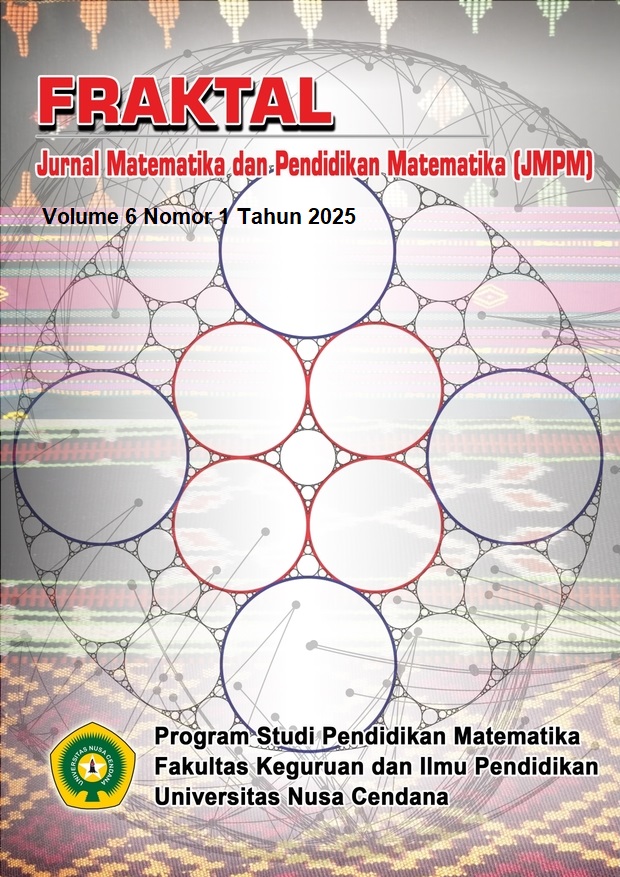Kesamaan Gender Pada Literasi Matematis Siswa: Implikasi Bagi Kesetaraan Gender Di Bidang STEM
Abstract
An adequate mathematical literacy allows individuals to comprehend core concepts in STEM fields, such as complex problem solving, analytical thinking, and methodical approach to challenges. Indonesian students’ mathematical literacy was still categorized in the low group according to PISA survey. In some countries, boys still outperformed girls which, in the long run, can lead to woman underrepresentation in STEM fields. Using secondary data collected during 2018/2019 academic year in Kupang, this research focused on examining public middle school students’ overall mathematical literacy based on gender as well as their performance in the process and content areas. The technique used to select 377 participants was two-stage cluster randomized sampling. Although there were only two categories of gender, the data were analyzed using One-Way ANOVAs to open possibilities for future research to analyze more than two groups. After the normality and homogeinity of variance had been confirmed, the data was then analyzed to examine gender patterns. The results revealed gender similarities in the overall as well as in the content and process domain of public middle school students’ mathematical literacy in Kupang. The results endorsed gender equality in mathematical literacy and contributed to career aspirations and decreasing gender prejudice in STEM education.
Downloads
References
Badan Pusat Statistik Indonesia. (2019). Keadaan Angkatan Kerja di Indonesia. Jakarta: BPS RI/BPS-Statistics Indonesia.
Borgonovi, F., Choi, Á., & Paccagnella, M. (2021). The evolution of gender gaps in numeracy and literacy between childhood and adulthood. Economic of Education Review, 82(102119). https://doi.org/10.1016/j.econedurev.2021.102119
Bureau of Labor Statistics. (2009). May 2008 National Occupational Employment and Wages Estimates. Washington, DC: Author.
Cavanagh, S. (2008). Stereotype of mathematical inferiority still plagues girls. Education Week, 28(1), 9. https://www.edweek.org/policy-politics/stereotype-of-mathematical-inferiority-still-plagues-girls/2008/08
Cohen, J. (1992). A power primer. Psychological Bulletin, 112 (1), 155-159. https://doi.org/10.1037/0033-2909.112.1.155
Dao Samo, D., Dominikus, W. S. and Kerans, D. (2020). Literasi matematis siswa sekolah menengah di Kabupaten Kupang (high school students’ mathematical literacy in Kupang regency). Fraktal: Jurnal Matematika dan Pendidikan Matematika (JMPM), 1(1), 39-48. https://doi.org/10.35508/fractal.v1i1.2973
Field, A. (2000). Discovering Statistics using SPSS for Windows. London: SAGE Publications Ltd.
Fointuna, D. W. (2021). Applying Mamdani’s method to categorize mathematical literacy of public middle school students in Kupang. J. Phys.: Conf. Ser. 1957 012009. http://dx.doi.org/10.1088/1742-6596/1957/1/012009
Fointuna, D. W., Kaluge, A. H. and Fernandez, A. J. (2020). An analysis of mathematical literacy of state junior high school students in Kupang. J. Phys.: Conf. Ser. 1422 012025. http://dx.doi.org/10.1088/1742-6596/1422/1/012025
Hidayatullah A., Csíkos C. (2022). Assessing students’ mathematics-related beliefs system in the Indonesian context. AIP Conf. Proc. 2633, 030014. https://doi.org/10.1063/5.0102302
Hidayatullah A., Csíkos C. (2023). Exploring Students’ Mathematical Beliefs: Gender, Grade, and Culture Differences. Journal on Efficiency and Responsibility in Education and Science, 16(3), pp. 186-195. https://doi.org/10.7160/eriesj.2023.160303
Hyde, J. S. (2005). The gender similarities hypothesis. The American Psychological Association, 60(6), 581-592. https://doi.org/10.1037/0003-066x.60.6.581
Hyde, J. S., Lindberg, S. M., Linn, M. C., Ellis, A. B. and Williams, C. C. (2008). Gender similarities characterize math performance. Science, 321(5888), 494–495. http://dx.doi.org/10.1126/science.1160364
Hyde, J. S. and Linn, M. C. (2006). DIVERSITY: Enhanced: Gender similarities in mathematics and science. Science, 314(5799), 599–600. http://dx.doi.org/10.1126/science.1132154
Jannah, R. D., Putri, R. I. I. and Zulkardi. (2018). PISA-like mathematics problem: The context of basketball in Asian Games. J. Phys. Conf. Ser. 1088 012019. http://dx.doi.org/10.1088/1742-6596/1088/1/012019
Kim, H. Y. (2013). Statistical notes for clinical researchers: assessing normal distribution (2) using skewness and kurtosis. ISSN 2234-7658 (print)/ ISSN 2234-7666 (online). http://dx.doi.org/10.5395/rde.2013.38.1.52
Krejcie, R. V. and Morgan, D. W. (1970). Determining sample size for research activities. Educational and Psychological Measurement, 30 (1), 607-610. https://doi.org/10.1177/001316447003000308
Lailiyah, S. (2017). Mathematical literacy skills of students in term of gender differences. AIP Conference Proceedings 1868, 050019. https://doi.org/10.1063/1.4995146
National Research Council. (2001). Adding it up: Helping children learn mathematics. In J. Kilpatrick, J. Swafford, & B. Findell (Eds.), Mathematics Learning Study Committee, Center for Education, Division of Behavior and Social Sciences and Education. Washington, DC: National Academy Press.
Nizar, H., Putri, R. I. I. and Zulkardi. (2018). PISA-like mathematics problem with karate context in Asian Games. J. Phys. Conf. Ser. 1088 012063. http://dx.doi.org/10.1088/1742-6596/1088/1/012063
OECD. (2005). PISA 2003 Technical Report. Paris: OECD Publishing.
OECD. (2013). PISA 2012 Assessment and Analytical Framework: Mathematics, Reading, Science, and Financial Literacy. Paris: OECD Publishing.
OECD. (2014a). PISA 2012 Data, in PISA 2012 Results: What Students Know and Can Do (Volume I, Revised edition, February 2014): Student Performance in Mathematics, Reading and Science. Paris: OECD Publishing.
OECD. (2014b). PISA 2012 Results: What Students Know and Can Do – Student Performance in Mathematics, Reading and Science. Paris: OECD Publishing.
OECD. (2015). The ABC of Gender Equality in Education: Aptitude, Behaviour, Confidence. Paris: OECD Publishing.
OECD. (2016a). PISA 2015 Assessment and Analytical Framework: Science, Reading, Mathematics, and Financial Literacy. Paris: OECD Publishing.
OECD. (2016b). PISA 2015 Results (Volume 1): Excellence and Equity in Education. Paris: OECD Publishing.
OECD. (2019a). PISA 2018 Result (Country Note): What 15-year-old Students in Indonesia Know and Can Do. Paris: OECD Publishing.
OECD. (2019b). PISA 2018: Insights and Interpretations. Paris: OECD Publishing.
Prabawati, M., & Herman, T. (2019). Mathematical literacy skills students of the junior high school in term of gender differences Mathematical literacy skills students of the junior high school in term of gender differences. Journal of Physics: Conference Series, 1315, 1– 6. https://iopscience.iop.org/article/10.1088/1742-6596/1315/1/012084
Rifai and Wutsqa, D. U. (2017). Kemampuan Literasi Matematika Siswa SMP Negeri Se-Kabupaten Bantul [Mathematical literacy of public middle school students in Bantul regecy]. Jurnal Pendidikan Matematika dan Sains, 4(2), 54-64. http://dx.doi.org/10.21831/jpms.v5i2.15747
Scafidi, T. and Bui, K. (2010). Gender similarities in math performance from middle school to high school. Journal of Instructional Psychology, 37(3), 252-255. https://www.semanticscholar.org/paper/Gender-Similarities-in-Math-Performance-from-Middle-Scafidi-Bui/6d296ac996c6e88d44282434edb369669d0118c2?utm_source=direct_link
Stacey, K. (2011). The PISA view of mathematical literacy in Indonesia. IndoMS. J. M. E., 2(2), 95-126. https://dx.doi.org/10.22342/jme.2.2.746.95%20-%20126
Welkowitz, J., Cohen, B. H. and Ewen, R. B. (2006). Introductory Statistics for the Behavioural Sciences Sixth Edition. Hoboken: John Wiley & Sons, Inc.
Yansen, D., Putri, R. I. I. and Zulkardi. (2018). Mathematical problems of PISA-like with the 200m swimming context in Asian Games. J. Phys. Conf. Ser. 1088 012086. http://dx.doi.org/10.1088/1742-6596/1088/1/012086
Copyright (c) 2025 FRAKTAL: JURNAL MATEMATIKA DAN PENDIDIKAN MATEMATIKA

This work is licensed under a Creative Commons Attribution-NonCommercial-ShareAlike 4.0 International License.
- Hak publikasi atas semua materi naskah jurnal yang diterbitkan/dipublikasikan dalam situs E-Journal Fraktal ini dipegang oleh dewan redaksi dengan sepengetahuan penulis (hak moral tetap milik penulis naskah).
- Ketentuan legal formal untuk akses artikel digital jurnal elektronik ini tunduk pada ketentuan lisensi Creative Commons Attribution-ShareAlike (CC BY-SA), yang berarti Jurnal Fraktal berhak menyimpan, mengalih media/format-kan, mengelola dalam bentuk pangkalan data (database), merawat, dan mempublikasikan artikel tanpa meminta izin dari Penulis selama tetap mencantumkan nama Penulis sebagai pemilik Hak Cipta.
- Naskah yang diterbitkan/dipublikasikan secara cetak dan elektronik bersifat open access untuk tujuan pendidikan, penelitian, dan perpustakaan. Selain tujuan tersebut, dewan redaksi tidak bertanggung jawab atas pelanggaran terhadap hukum hak cipta.

 Daniel Williams Fointuna(1*)
Daniel Williams Fointuna(1*)










